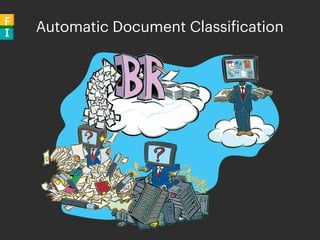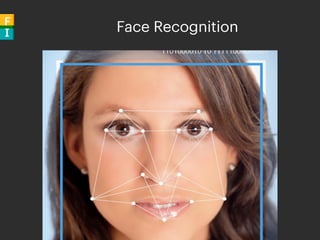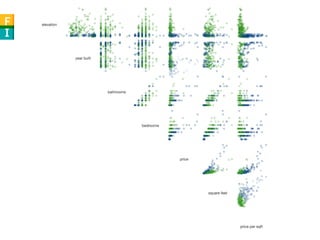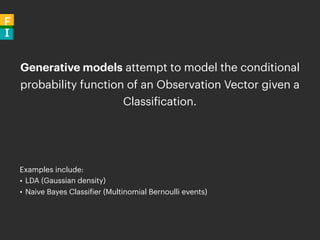Introduction to Machine Learning Classifiers
- 1. Very, Very Basic Introduction to Machine Learning Classification Josh Borts
- 2. Problem Identify which of a set of categories a new observation belongs
- 3. Classification is Supervised Learning (we tell the system the classifications) Clustering is Unsupervised Learning (the data determines the groupings (which we then name))
- 4. Examples
- 5. Handwriting Recognition / OCR
- 6. Spam Filters
- 10. SHAZAM!!
- 12. Observations an Observation can be described by a fixed set of quantifiable properties called Explanatory Variables or Features
- 13. For example, a Doctor visits could result in the following Features: • Weight • Male/Female • Age • White Cell Count • Mental State (bad, neutral, good, great) • Blood Pressure • etc
- 14. Text Documents will have a set of Features that defines the number of occurrences of each Word or n-gram in the corpus of documents
- 15. Classifier a Machine Learning Algorithm or Mathematical Function that maps input data to a category is known as a Classifier Examples: • Linear Classifiers • Quadratic Classifiers • Support Vector Machines • K-Nearest Neighbours • Neural Networks • Decision Trees
- 16. Most algorithms are best applied to Binary Classification. If you want to have multiple classes (tags) then use multiple Binary Classifiers instead
- 17. Training A Classifier has a set of variables that need to set (trained). Different classifiers have different algorithms to optimize this process
- 18. Overfitting Danger!! The model fits only the data in was trained on. New data is completely foreign
- 20. Among competing hypotheses, the one with the fewest assumptions should be selected
- 21. Split the data into In-Sample (training) and Out-Of-Sample (test)
- 23. Of course there are many ways we can define Best Performance… Accuracy Sensitivity Specifity F1 Score Likelihood Cumulative Gain Mean Reciprocal Rank Average Precision
- 24. Algorithms
- 25. k-Nearest Neighbor Cousin of k-Means Clustering Algorithm: 1) In feature space, find the k closest neighbors (often using Euclidean distance (straight line geometry)) 2) Assign the majority class from those neighbors
- 26. Decision Tress Can generate multiple decision trees to improve accuracy (Random Forest) Can be learned by consecutively splitting the data on an attribute pair using Recursive Partitioning
- 27. New York & San Fran housing by Elevation and Price
- 31. Linear Combination of the Feature Vector and a Weight Vector. Can think of it as splitting a high-dimensional input space with a hyperplane
- 32. Often the fastest classifier, especially when feature space is sparse or large number of dimensions
- 33. Determining the Weight Vector Can either use Generative or Discriminative models to determine the Weight Vector
- 34. Generative models attempt to model the conditional probability function of an Observation Vector given a Classification. Examples include: • LDA (Gaussian density) • Naive Bayes Classifier (Multinomial Bernoulli events)
- 35. Examples include: • Logistic Regression (maximum likelihood estimation assuming training set was generated by a binomial model) • Support Vector Machine (attempts to maximize the margin between the decision hyperplane and the examples in the training set) Discriminative models attempt to maximize the quality of the output on a training set through an optimization algorithm.
- 36. Neural Network Not going to get into the details, this time….






































